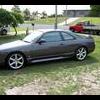A/m Injectors Into Rb25
Announcements
-
Similar Content
-
Latest Posts
-
I guess when I say it's a POS I mean.. the solution and the stuff has the capacity for maybe... 1 spot. You know, as a spot cleaner. What I really *want* is the ability to do an entire car, all upholstery, all carpet, mats, all seats, door card inserts, A pillars, roof liners, etc. In one go. I get lured by all the jank that comes out and think "I'd like to be able to clean to that degree"
-
I've got one (not the car one, the domestic spot cleaner one, which is basically the same jobbie) and have driven it hard for hours and hours at a time. Grimy sofas, 6' floor rugs, etc. I'd blame your specific example rather than the whole category. I haven't used mine in the car, because.... you know, it's my car. So there is no-one else's ball sweat in the driver's seat, there's no kid food/drink spills or hand prints inside because they've never had an opportunity to put them there. You know, basic, standard Skyline rules.
-
I normally run with I think a 10mm, and definitely use the second handle you can add to a drill. They hurt when they bins up! For the crush tube, once all subframe is clear, I'd try some stilsons and see if I can get it to start to twist.
-
Probably because they couldn't, because the use of the variable resistor to create a "signal" in the ECU is managed by the ECU's circuitry. The only way that VDO could do it would be if they made a "smart" sensor that directly created the 0-5V signal itself. And that takes us back to the beginning. Well, in that case, you could do the crude digital (ie, binary, on or off) input that I mentioned before, to at least put a marker on the trace. If you pressed the button only at a series of known integer temperatures, say every 2°C from the start of your range of interest up to whatever you can manage, and you know what temperature the first press was at, then you'd have the voltage marked for all of those temperatures. And you can have more than one shot at it too. You can set the car up to get the oil hot (bypass oil coolers, mask off the air flow to oil coolers, and/or the radiator, to get the whole engine a bit hotter, then give it a bit of curry to get some measurements up near the top of the range. On the subject of the formula for the data you provided, I did something different to Matt's approach, and got a slightly different linear formula, being Temp = -22.45*V + 118.32. Just a curve fit from Excel using all the points, instead of just throwing it through 2 points. A little more accurate, but not drastically different. Rsquared is only 0.9955 though, which is good but not great. If you could use higher order polynomials in the thingo, then a quadratic fit gives an excellent Rsquared of 0.9994. Temp = 2.1059*V^2 - 34.13*V + 133.27. The funny thing is, though, that I'd probably trust the linear fit more for extrapolation beyond the provided data. The quadratic might get a bit squirrely. Hang on, I'll use the formulae to extend the plots.... It's really big so you can see all the lines. I might have to say that I think I really still prefer the quadratic fit. It looks like the linear fit overstates the temperature in the middle of the input range, and would pretty solidly understate what the likely shape of the real curve would say at both ends.
-
I got a hand held bisssel one and it's a piece of shit. Doesn't work for more than about 5 seconds. So much so that I nearly refuse to believe any wet dry vac actually works or has enough suction to clean the carpet of a car. I'm discouraged as all the good ones are $300+ for an unknown result. I saw MCM did a Ryobi video where they use this thing: https://www.ryobi.com.au/products/stick-vacuum-cleaners/18v-one-hptm-brushless-spot-cleaner-tool-only Anyone have any experience actually using a tool like this when not paid to showcase it?
-








Recommended Posts
Create an account or sign in to comment
You need to be a member in order to leave a comment
Create an account
Sign up for a new account in our community. It's easy!
Register a new accountSign in
Already have an account? Sign in here.
Sign In Now